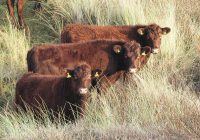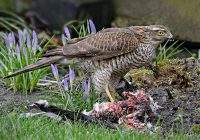Dr Phil Smith’s Wildlife Notes
February 2017
The driest autumn and winter in living memory continued for the first part of the month with measurable rainfall on only three days up to the 17th. Finally, more normal Atlantic conditions reasserted themselves, with high winds of storm “Doris” rattling in on 23rd. At last, some proper rain fell on each day from 21st to 28th. Nevertheless, this had minimal impact on the depleted water-table. At the Devil’s Hole, I found the level had risen by only 4cm by the end of the month, being still 12cm below the ground surface. A Common Frog was hiding in my measuring hole!
As usual, February produced plenty of signs of spring, Patricia Lockwood reporting a Red Admiral butterfly on the first day. Snowdrops were fully out by the 5th at Range Lane and Cabin Hill Wood, the latter producing a spectacular display later on. Hightown dunes had a Yellow Crocus on 14th, while the joyous song of a Skylark and the first flowers of Colt’s-foot uplifted my spirits at Birkdale Green Beach the day before. Primroses were just starting to flower at Cabin Hill at the month’s end, while a week earlier, Alder catkins were prolific at the Green Beach and the starry white flowers of Blackthorn lined the roadside at Woodvale. The first of the dune annuals, Common Whitlow-grass, appeared at Hesketh Road, Marshside on 16th. Migrant birds were also on the move, the earliest Avocets being reported at RSPB Marshside on 19th and on the same day at the Wildfowl & Wetlands Trust Martin Mere. By the end of the month, the latter site had 50 of these elegant black-and-white waders.
Meanwhile, wintering birds were still very much in evidence. Visiting Hightown for the high-tide in mid-month revealed a variety of waders roosting on the protected beach off Altcar Rifle Range. I counted about 800 Oystercatchers, 450 Curlew and 150 Redshanks. Nineteen Black-tailed Godwits dropped in a few yards from me to feed on a patch of mud off the Sailing Club. While they probed for rag-worms with their long straight bills, a flock of Dunlin picked smaller food items from the surface. They were joined by a Grey Plover, with its distinctive checker-board plumage, together with two Ringed Plovers and a Turnstone; quite a nice selection. The wintering Mediterranean Gull was still at Southport Marine Lake mid-month but spurned my offer of bread, appearing only briefly to reveal an almost complete black hood. Sands Lake had its usual ducks, including up to 21 Tufteds and 11 Shovelers. I also saw three Pochards, though others reported up to 15, a good number as this red-headed diving duck is rapidly declining throughout Europe. Numbers wintering in the UK have dropped by 80% since the 1980s. This is thought to be due to declines of Black-headed Gull colonies in which Pochards nest for protection, nutrient enrichment of feeding waters and predation by introduced American Mink.
Visiting Ainsdale Sand Dunes National Nature Reserve with Joshua Styles to look for mosses and liverworts (bryophytes), I was delighted to find a plant of Hard Fern, a rarity on the coast recorded from only one other locality. Later, Josh sent me an impressive list of 43 bryophytes he found on Freshfield Dune Heath, 16 being new to this reserve.
At Ainsdale Sandhills Local Nature Reserve, I was entertained by 16 small friendly Redpoll cattle, doing a great job of grazing down the coarse vegetation on the inner dunes. The condition of this area has improved noticeably in the last few years, with patches of bare ground and sandy tracks ideal for colonising by small plants and insects. I was also able to walk into the largest slack, normally deeply flooded at this time of year. Immediately obvious was a large stand of Purple Moor-grass, an uncommon species here more typical of peaty Pennine uplands. Even better was a large willow bush with flame-red stems, almost certainly of the extremely rare hybrid Don’s Willow, known to occur in only three places in the UK. I will return to confirm its identity when catkins appear in April. Talking to staff of Coast & Countryside, it was disappointing to learn that two of the Herdwick sheep on the Ainsdale reserve had been found dead after a dog attack and that two dogs were seen chasing Redpoll cattle on the Birkdale Sandhills LNR. I included these with many other incidents in a 21-page report on dog-related problems on the Sefton Coast which I decided to write after hearing of Sefton Council’s public consultation on a proposed Public Space Protection Order. This would add to existing controls on dogs using public land, though how they could be enforced is not clear. Evidence cited in my report suggests that a combination of reasonable regulation and positive engagement with dog owners is most likely to provide a solution to the Sefton Coast’s undoubted dog problems.
Finally, Trevor Davenport sent me a splendid photograph of a large female Sparrowhawk which killed a Wood Pigeon in his Freshfield garden, returning repeatedly for several days to feed on the carcass.




